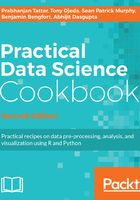
How it works...
R is an interpreted language that appeared in 1993 and is an implementation of the S statistical programming language that emerged from Bell Labs in the '70s (S-PLUS is a commercial implementation of S). R, sometimes referred to as GNU S due to its open source license, is a domain-specific language (DSL) focused on statistical analysis and visualization. While you can do many things with R, not seemingly related directly to statistical analysis (including web scraping), it is still a domain-specific language and not intended for general-purpose usage.
R is also supported by CRAN, the Comprehensive R Archive Network (http://cran.r-project.org/). CRAN contains an accessible archive of previous versions of R, allowing for analyses depending on older versions of the software to be reproduced. Further, CRAN contains hundreds of freely downloaded software packages, greatly extending the capability of R. In fact, R has become the default development platform for multiple academic fields, including statistics, resulting in the latest and greatest statistical algorithms being implemented first in R. The faster R versions are available in the Microsoft variants at https://mran.microsoft.com/.
RStudio (http://www.rstudio.com/) is available under the GNU Affero General Public License v3 and is open source and free to use. RStudio, Inc., the company, offers additional tools and services for R as well as commercial support.